INVISALIGN® CLEAR ALIGNERS – DOWNERS GROVE, IL
Straighten Smiles Seamlessly
At Esplanade Dental Care, Dr. Albert, Dr. Snow, and Dr. Stylski understand the pressures that many patients face when it comes to maintaining a professional, polished appearance. If you’re interested in straightening your teeth but unwilling to undergo traditional orthodontic treatment because of its unnatural appearance, Invisalign in Downers Grover is an excellent, image-friendly alternative. Please contact us today if you’re interested in exploring this option further with an initial consultation.
Why Choose Esplanade Dental Care For Invisalign?
- Dental Insurance Welcome & Flexible Financing Available
- Team of Experienced Dentists Who Truly Care
- Evening Appointments Available to Make Your Treatment Convenient
How Invisalign Works
What to Expect at Your Invisalign Consultation

During your initial consultation, we’ll evaluate your oral health and your orthodontic needs. Besides a visual examination, we will also take X-rays, images, and molds of your mouth to determine if you’re a candidate for Invisalign. We’ll also discuss your lifestyle habits and the results you want to achieve to ensure it’s the best choice for you. While most patients are good candidates for Invisalign treatment, severe problems are typically better treated with traditional braces.
Once we’ve determined that Invisalign is a good choice for you, we’ll walk you through your entire treatment plan step-by-step so you’ll know exactly what to expect. Of course, we’ll also take the time to answer any questions you may have about your treatment as well! Afterwards, we’ll also go over your personalized estimate of costs, as well as all you payment options and how to make Invisalign affordable with financing through CareCredit.
Who Can Invisalign Help?
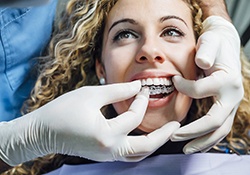
In many cases, Invisalign is a perfect solution for those wanting to improve minor bite misalignment issues. Apart from crooked teeth, our doctors may recommend these clear aligners for patients with the following orthodontic concerns:
Crowded Teeth
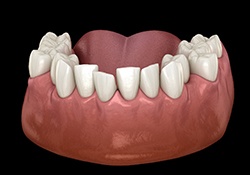
If your teeth are too close together, tooth decay and gum disease can become a real problem. Trapped bacteria and food particles can cause cavities and infections to develop. To prevent this from happening, Invisalign can create the space needed for your teeth to be in proper alignment.
Gaps Between Teeth
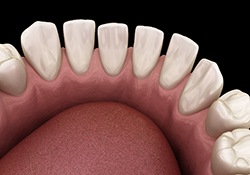
Just like too little space can be a problem, so can too much space. When gaps between your teeth cause food to become trapped, your risk for cavities increases. By seeking treatment with Invisalign, the aligners will gently shift your teeth to close these gaps and eliminate future problems.
Overbite
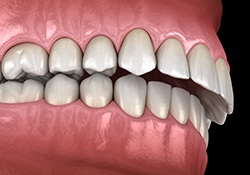
An overbite is when your top teeth seem to rest way too far in front of your bottom teeth. This can often result in problems like jaw pain, uneven dental wear, difficulty opening and closing the mouth, and speech complications. The upper arch can also end up being more vulnerable to damage or injury because they won’t have the proper support from the lower arch. Invisalign can help bring both arches of teeth together for a more comfortable bite.
Underbite
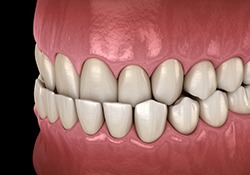
When the bottom row of teeth protrudes further out in front of the top row, this is known as an underbite. This can sometimes be due to factors like jaw injury, genetics, and oral habits like thumb-sucking. To correct this, we might use Invisalign aligners along with elastic bands to shift your lower arch back into its proper position slightly behind your upper arch.
Crossbite
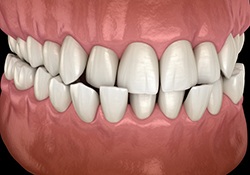
In certain cases, some of a patient’s bottom teeth might sit just in front of the upper ones, and vice versa. Whether this was a result of genetics, premature loss of baby teeth, or poor oral habits, an untreated crossbite can end up increasing the risk of gum disease, tooth decay, teeth grinding, headaches, speech complications, and facial asymmetry. While we can use Invisalign to help correct this, we might need to accompany your trays with rubber bands and other accessories if the misalignment is due to issues with jaw development.
Open Bite
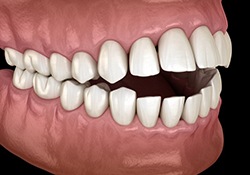
An open bite is when both the upper and bottom front teeth won’t touch each other while biting down or closing your mouth. This can be caused by things like nonnutritive habits (thumb-sucking, pacifier use, etc.) or poor bone development. If left unaddressed, an open bite can make it more likely to experience trouble with pronunciation and excessive wear and tear of your rear teeth. With Invisalign and other accessories like elastic bands, we can correct your arches so that you can enjoy a proper bite.
The Benefits of Invisalign
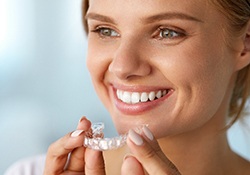
Invisalign is quickly becoming the most popular way for teens and adults alike to achieve the happy, healthy smile they deserve. There are many benefits that these clear aligners offer that can make your journey towards straighter teeth and a more aligned bite as pleasant as possible! Read on to learn more about just some of the benefits that our patients love the most about Invisalign.
Invisible Treatment, Natural Appearance

As the name implies, Invisalign aligners are the ideal treatment option for patients who want to maintain a natural appearance. While not entirely invisible, the aligners themselves are so thin and discreet that they’ll usually be missed by people you interact with on a regular basis.
Removable for Optimal Convenience

With Invisalign, you can easily brush and floss like normal at home because the aligners are removable. You could even take them out for short periods of time if you’d like to look your very best for a special event or a photo. Generally, patients will need to ensure that they’re wearing their aligners for at least 22 hours a day to achieve optimal results.
No Food Restrictions

If you asked individuals who wear Invisalign what their favorite aspect is about treatment (apart from the invisible aligners), they would probably tell you it’s that there are no food restrictions. With traditional braces, it can be difficult to enjoy many of the foods you love because of the possibility that it will get trapped in the brackets and wires or break them, but with Invisalign, all you need to do is remove your trays prior to eating, allowing you to eat whatever you want! Just remember to place your trays in a protective case to prevent damage.
Improved Comfort
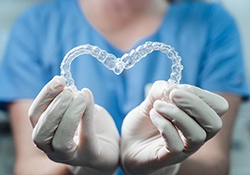
One of the greatest aspects of Invisalign is that there are no metal wires or brackets to irritate the soft tissues of your mouth. Traditional brackets and wires often dig into the soft tissues in the mouth, like the tongue, cheeks, gums, and lips, causing chronic discomfort for patients. The clear, smooth plastic of Invisalign aligners is very comfortable in comparison! Invisalign aligners are biocompatible and should cause absolutely no discomfort for you soft tissues.
Faster Treatment Time

Traditional braces can often require two or three years to be fully effective. While every case of Invisalign treatment is different, patients can expect to be finished on a speedier timeframe of 12 months on average. Considered to be one of the quickest orthodontic treatments available, the clear aligner technology makes it possible for you to receive treatment faster as well as reduce the amount of time you must spend in the dentist chair.
Living with Invisalign Aligners

Are you curious if you’ll need to change your diet with Invisalign? Do you want to learn a bit more about the commitments you’ll need to make, including how often the check-in visits are? Good news: in this next section, we’re answering these questions and providing insight on everything else you need to know about living with Invisalign!
Wear Your Aligners for 20+ Hours a Day
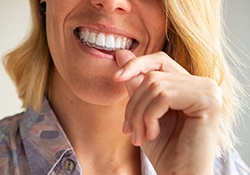
Arguably the most important rule of Invisalign is that you wear the aligners for 20+ hours a day. If you don’t, then there’s a good chance that your teeth won’t track as anticipated and, in turn, there will be treatment plan delays. One of the easiest ways to make sure you’re wearing your trays enough is by using the stopwatch on your phone throughout the day. If you have trouble remembering to put them back in, you can also set a reminder to help!
Clean Your Trays Consistently
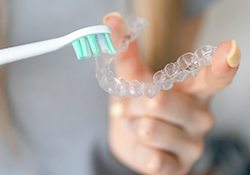
One thing you will need to change about your day-to-day routine is adding a few minutes to your dental care regimen to clean your aligners. Otherwise, they will begin to take on a noticeable yellow tone. The good news is that you only need two things to keep your trays clean and clear: water and a soft-bristled toothbrush. Just make sure that you always check the temperature of the water first. If it’s too hot, it can cause your aligners to warp!
The Key to Eating and Drinking with Aligners

There is really only one rule when it comes to eating: you need to take your trays off first. Of course, there are other guidelines we recommend, like filling your plate with nutrient-dense foods as much as possible and keeping sugary and starchy ones to a minimum.
Important note: You need to take your trays off before drinking iced coffee! In fact, you should remove them before enjoying any dark-colored beverages, like soda and juice, as well.
What To Do If You Lose a Tray

Like most patients, you might feel like your heart has sunk into your stomach when you realize that your trays aren’t where you thought they were. Instead of panicking, do your best to remember where you saw them last and retrace your steps from there. In the process, look in the center console of your car, between the cushions on your couch, and even in your fridge – you never know where they may have ended up! If you can’t find them after looking and looking, then give us a call.
Prioritize Your Routine Check-Ins
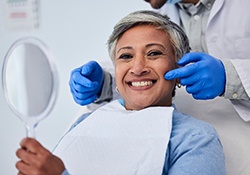
During your Invisalign treatment, you’ll be given several sets of aligners at once. As a result, the check-in visits are usually every six to eight weeks instead of every four. Make sure to attend every single one so we can continuously monitor your progress and, if necessary, make adjustments to your treatment plan.
How Much Does Invisalign Cost?
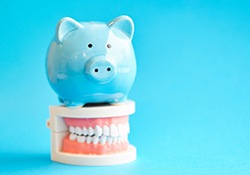
If you’re ready to move forward with Invisalign aligners, we’re happy to hear it! But first, it’s important that you know how much you can expect to pay for treatment. Only during a consultation with a dentist in Downers Grove will you receive a confirmed estimate of how much your Invisalign will cost. Each patient and treatment timeline is different, so don’t expect to pay the same as your co-worker who had them last year. However, treatment is likely more affordable than what you’ve heard.
Factors That Influence the Cost

There is not a set price for Invisalign because the cost is determined by various factors that are unique to your treatment plan, like the severity of your case. If you have significant bite and alignment issues, you’ll need more aligners than a person who only has minor concerns, which will increase the cost.
We’ll provide you with a personalized estimate during your initial consultation and discuss the costs of your treatment. We’ll help you find the solutions you need to get a straight smile without breaking the bank.
Is Invisalign Worth the Investment?

The appearance of your teeth directly influences your self-esteem. Correcting your alignment concerns can improve how you see your smile, giving your confidence a boost. This new outlook on life begins with clear aligners.
Invisalign is not only an investment in your self-esteem, but also your dental health. When your teeth aren’t in their ideal positions, they are more difficult to clean thoroughly. This increases your risk of tooth decay and gums disease. Correcting your alignment concerns makes your oral hygiene more effective to reduce your risk of common dental issues.
Alignment problems can also cause complications with your bite. This can lead to uneven wear on your enamel that increases your risk of several problems, like tooth decay or a fracture. This can also cause strain on your temporomandibular joints, which are located on either side of your face and connect your jaw to your skull. Correcting your bite will improve your oral health and also your quality of life by preventing unnecessary jaw pain.
Invisalign FAQs
Is Invisalign Painful?
Every type of orthodontic treatment works by applying pressure to the teeth to move them into their ideal positions, so some initial discomfort is to be expected (particularly in the beginning as there’s an adjustment period of several days to a week). Having said that, Invisalign is generally less painful than traditional braces. Also, you don’t have to worry about the irritation to your lips, gums, cheeks, etc. that comes with metal brackets and wires.
Will Invisalign Affect My Speech?
For the first few days, some patients have a slight lisp while they’re adjusting to their trays. After that, they’re able to articulate clearly without any trouble. Many people don’t have any speech issues at all.
How Do I Care for My Invisalign Aligners?
- Use gentle pressure to put your trays in and take them out to avoid cracks or fractures.
- To minimize the chance of accidentally throwing your trays away, make it a habit to store them in their protective case during meals instead of a napkin.
- Brush after meals to prevent any food residue from staining your trays, especially if you’ve eaten things like turmeric, blueberries, or tomato sauce.
- To avoid warping your aligners, don’t expose them to hot temperatures.
- To clean your trays, use only specially-made products (you can get these from us) or clear liquid soap. Don’t use toothpaste or denture cleaner because these products can scratch your aligners.
- Only drink plain water when your trays are in. Anything else can stain them, break them, or give them a bad odor.
Are Invisalign Results Permanent?
Invisalign has the potential to give you a beautifully straightened smile for life, but only if you wear a retainer according to our instructions after your treatment. After your teeth have been moved, whether with metal braces or Invisalign, using a retainer is a must to prevent them from shifting. For Invisalign, you’ll use clear retainer trays that look and feel very similar to your aligners. After your treatment, we’ll review how long you’ll need to wear your retainers. At first, you’ll likely need to wear them at least 22 hours per day, but eventually only at night.
Is There Anything I Can’t Eat with Invisalign?
Since your Invisalign aligners are removable, you won’t have to worry about altering your diet in any way! With that said, there are a few things you should keep in mind, especially if you have a lot of attachments. That starts with exercising caution when eating crunchy foods and extends to not consuming sugar in excess.
Remember, your diet directly impacts your oral health. Furthermore, your oral health impacts your Invisalign treatment. If you develop cavities, gum disease, or another serious dental problem, then we will need to intervene with the necessary treatment, temporarily putting your treatment plan on hold. All that to say, make sure to eat a well-balanced diet filled with nutrient-dense, smile-friendly foods, such as plain yogurt and oatmeal.
How Long Does Invisalign Take?
On average, Invisalign treatments are between 12 and 18 months. However, this isn’t necessarily a reflection of how long it will take for you to achieve the results you desire. We need to consider numerous factors before providing you with an estimate, including the complexity of your case. Furthermore, you can easily add more time onto the back end of your treatment if you don’t follow the guidelines, like wearing your aligners for 20-22 hours a day.
Can I Drink Coffee with Invisalign?
If you like starting your morning with a cup of coffee or enjoy sipping on this caffeinated beverage as an afternoon pick-me-up, good news – you can drink coffee during your Invisalign treatment! There is, however, one rule: you can’t consume dark-colored beverages with your aligners in. So, always remove your trays and store them properly before indulging. After you’re done, rinse your mouth thoroughly with clean water. About 20 minutes later, brush your teeth.
What Happens After Invisalign?
Heading into your final appointment, you might be wondering, “What’s next?” First, we will remove your final attachments (if you have any) and take impressions of your teeth to create your custom retainers. The good news is that retainers today are as discreet and comfortable as your trays, which makes wearing them consistently feel like less of a chore. Of course, the instructions we provide vary slightly from patient to patient, but it’s a general best practice to wear your retainer at least every evening while you sleep.
Who Isn’t a Candidate for Invisalign?
With more than 12 million patients around the globe, it’s safe to say that Invisalign is a good fit for a large number of patients. However, like any dental treatment, there are a few things we need to consider before determining if you are a candidate for clear aligner treatment. One example is the complexity of your case. While Invisalign can correct overcrowding, spacing issues, and bite misalignment, it isn’t ideal for severe cases of malocclusion. Fortunately, hybrid treatment may be an option, which is when you begin your teeth-straightening journey with traditional braces and then transition to clear aligners after a few months.

